Rancho Gordo’s Heirloom Beans
As we all know around here, I love beans. (They are the magical fruit, right?)
When I met Zak, he told me he didn’t like beans. I was like, “What?” But then, I quickly understood–he had never had them except out of a can, and if there is something that might well make someone dislike beans, it’s those mushy, flavorless critters that come out of cans masquerading as beans. It doesn’t matter what kind of bean they say they are, or what color they are, most of them taste the same–blah. Kinda mealy, kinda mushy, very yucky.
So, I proceeded to cook him a pot of proper pinto beans, made the old hillbilly way with a ham hock (I can feel the vegetarians wincing, but well, beans taste mighty good that way and I wanted to make sure to hook him before I went all vegetarian on him) a bay leaf, an onion and a garlic clove and lots of water which turns into a delicious bean broth that was always my favorite part of beans when I was a kid. Mother thought I was weird, but I liked to drink a cup of it right out of the pot, I liked it so well. (I did the same with the liquid kale is simmered in, too–she told my doctor about it and he said, “Let her do it! That’s where most of the vitamins have escaped to!)
Well, needless to say, Zak was converted, and we’ve had lots of beans in our pantry ever since.
Recently, I’ve been keeping Athens very own Shagbark Seed & Mill Company’s black turtle beans in my pantry and have been using them for all sorts of purposes–as a plain old pot of beans, drained and used to top nachos, in salsas, in tacos and in enchiladas. And they are mighty good, no, not just good, but delicious, with a nice chew to the skins with creamy, sweet interiors. And they make fine broth.
And I’ve heard tell that Michelle and Brandon are offering pinto beans this fall after they get harvested–glory hallelujah, and praise be! I’m waiting impatiently to taste those, because when I was growing up, pinto beans and cornbread were a big favorite, especially in the late fall or winter. I never tired of them, even when we ate them a whole lot when Dad was laid off for a year and we went from “somewhat impoverished” to “downright poor.” Even eating them several times a week didn’t dampen my enthusiasm for them. Pintos are just that good, and I cannot wait to taste ones fresh from the field, because I know they’ll be better than the ones from the store which could have been hanging around for who knows how long.
BUT, you know, a reader named Laughingrat commented when I wrote about Shagbark’s black beans and clued me into a company that grows and sells heirloom varieties of dried beans out in California, called Rancho Gordo.
And you know how I am. I looked at their website, and saw all the beautiful beans in all their glorious colors: yellow, red, purple, black, piebald black and white or brown and white, streaked, spotted and speckled, pink, and celedon green–and of course, I was smitten. I’m a sucker for colors, and even though I knew darned good and well that when you cook dried beans most of those luscious pigments melt away and you end up with beans in some shade of creamy beige or brown, I couldn’t help it–I had to know if these beans were indeed any more special than the ones that came from the grocery store.
Steve Sando, the owner of Rancho Gordo and the Guru of Legumes, writes eloquent descriptions of the flavors and textures of the different legumes he offers in his online catalog and at his retail outlet in Napa, as well as in San Francisco, and his words haunted me. Because, I just had to know if his beans were just as good as the beans grown here in Athens.
So, I ordered a couple of pound packages for myself and a full dozen packages as a Father’s Day gift for Zak’s dad, Karl. (Karl is a bean aficionado, just like me.)
And, I finally got around to testing out three of the varieties from Rancho Gordo: “Pebbles,” which is a fascinating bean in that from the same plant come beans of all different shades of brown, pinkish beige, black and yellow, “Yellow Indian Woman,” which is widely grown among the Native American tribes in the northern plains (though it was originally brought to Montana by a Swedish family) and “Eye of the Goat,” which looks like a very fat, rounded, glossy pinto bean.
And here’s what I found out–Sando’s beans from Rancho Gordo have the same qualities of freshness that I found in Shagbark’s beans. They cook slightly faster than grocery store dried beans, probably because they’ve not been sitting in a warehouse for years on end. They also have more flavor–a LOT more flavor–and each type has a different character. And, finally–their textures are more varied than most grocery store beans–each type of bean has a distinctive texture–just as the black beans from Shagbark had tougher skins, but very creamy interiors, which led to them being paradoxically both slightly chewy and yet melting in the mouth.
I cooked all three types the same–in a pot with a bay leaf, a small amount of smoked pork (a small hunk of ham hock), a small whole onion and a whole clove of garlic. Then, I used each one in several ways to see how versatile they were in the context of different recipes.
The first one I cooked was “Pebbles.” You know I had to see what they were like, because they really do look like a bunch of river-polished stones. If you drilled holes in these beans and strung them up, they’d look like a necklace of agate beads–they really are that pretty, as you can see from the photo. (Maybe I should attempt to string some of them into a bracelet, if not a necklace.)
I used the cooked, drained beans to top nachos made with Shagbark’s amazing corn tortilla chips and some really lovely aged cheddar, and Kat and Zak and I loved them. Kat proclaimed them the “bestest bean nachos ever,” and Zak said that the beans had a slightly sweet flavor that was interesting.
Also, I noticed that while the differences between the colors of the cooked beans was not as startling as with the raw beans, they still showed subtle variations that made them look pretty neat on the plate.
I also ended up using these in a taco filling and as the filling to some vegetarian enchiladas that included grilled corn cut from the cobs and summer squash, and even in those contexts, the beans retained their sweet flavor and textural character.
The next beans I cooked were the “Yellow Indian Woman” beans, but I neglected to take photographs of them, either before or after they were cooked. They start out as ovoid brownish yellow beans and cook up to a pale pinkish brown. Their skins are somewhat tough so they retain their shape very well, even when cooked in a pressure cooker. Their flavor is distinctly earthy and sweet, and when I made them into refried beans, they had a silky, creamy texture that Kat and I adored.
Zak liked them, too, but he prefers the beans I cooked today to use in a refried bean dip to go with my salsa for a potluck at Kat’s preschool.
These beauties are known as “Ojo de Cabra,” or, “Eye of the Goat,” and at first glance they don’t look all that special. I mean, yeah, they’re pretty, but really they look like really pinto beans that went on an eating binge and are about to burst their skins, they’ve gained so much weight from all their gobbling.
But they don’t taste like pintos. They have a very fresh, sweet flavor with a hint of mushroomy depth. Steve Sando says likes to cook them simply and then serve them with some grated raw onion and a squeeze of lime juice and a bit of salt. You can see my version pictured in the blue bowl near the top of this post–I diced the onions finely instead of grating them, added minced cilantro along with the salt and a sprinkle of Aleppo pepper flakes just before the lime juice squeeze.
And you know what–that makes a fine bowl of beans. And it showcases the very meaty texture of the Goat Beans as I’ve come to call them. That’s what I ate for lunch today.
But for the potluck tonight, I mashed the beans and fried them with fresh onion and garlic in a bit of bacon fat melted with olive oil, and Zak said he absolutely loved the fuller, deeper texture of these beans to the creaminess of the “Yellow Indian Woman” beans. He said that the texture was firmer and a bit drier, but it made the beans taste somehow nutty in addition to just plain good.
So now we have a new favorite refried bean bean.
That is, until Shagbark’s pintos come in.
Then, we’ll see whose beans come out on top.
Until then, let it be known that I highly approve of the heirloom beans Sando is offering through Rancho Gordo–and while I’m at it–his two books, The Rancho Gordo Heirloom Bean Grower’s Guide: Steve Sando’s 50 Favorite Varieties and Heirloom Beans: Great Recipes for Dips and Spreads, Soups and Stews, Salads and Salsas, and Much More from Rancho Gordo are downright awesome, too.
Both are filled, cover to cover, with bean lore, cultivation information, recipes, and description of the individual characteristics and flavors of a whole array of heirloom beans, and are equally filled to the brim with Sando’s very infectious leguminous enthusiasm. Both books are well worth checking out, though the second book is more a cookbook that is geared toward foodies, while the first has essential bean cultivation information, as well as descriptions of the beans, their histories and a few recipes featuring them that aren’t included in the first second book.
So there we are–check out Rancho Gordo and see what you think of their heirloom beans–because they really are just that good.
Now, I’m going to stop writing and wait impatiently for Shagbark’s pinto beans to be ready to harvest…..
4 Comments
RSS feed for comments on this post.
Sorry, the comment form is closed at this time.
Powered by WordPress. Graphics by Zak Kramer.
Design update by Daniel Trout.
Entries and comments feeds.

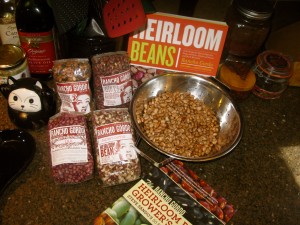
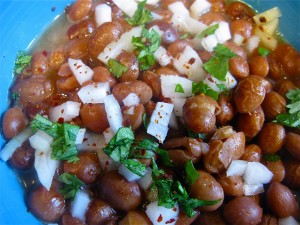
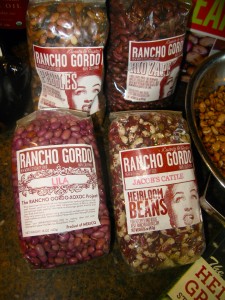
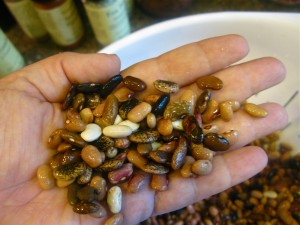
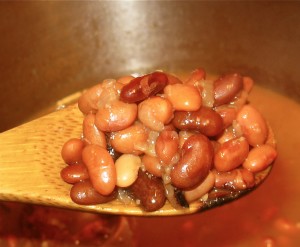
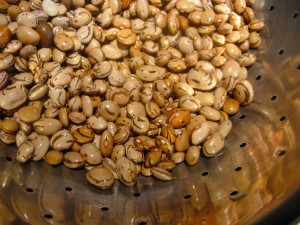


Mmm. I love beans. I don’t cook them from dried as often as I’d like, because I truly SUCK at planning that far ahead. I was excited to find fresh shell beans (cranberry beans) at the farmers’ market the other day, though, and I made an absolutely amazing ragu with them, some onions, some cherry tomatoes, and a few other things, which I ate on top of bulgur. So tasty, and so healthy.
Comment by Laura B. — August 18, 2011 #
I have a couple of bags of Rancho Gordos. Do you have a general method of preparation (crock pot would be awesome) that you recommend?
Comment by SA — August 18, 2011 #
Barbara,
Yeah, aren’t Rancho Gordo great? Even in SF, though, we don’t have a store which stocks all their varieties regularly; I have to wait and catch them at the Saturday Farmer’s Market. So worth it, though!
Comment by FuzzyChef — August 21, 2011 #
Oh, I love heirloom beans. I grow some in my garden. I know it seems like a lot of trouble to grow dry beans in a garden when they’re so cheap at the store, but sometimes it’s the only way one can find some of these unusual varieties.
I do think it’s a little sad that beans lose so much of their beauty when they’re cooked. I grow Calypso beans, which are black and white spotted, and when cooked the black kind of seeps out and stains the white part of the bean grey.
But they sure are tasty!
Comment by Amanda — August 28, 2011 #